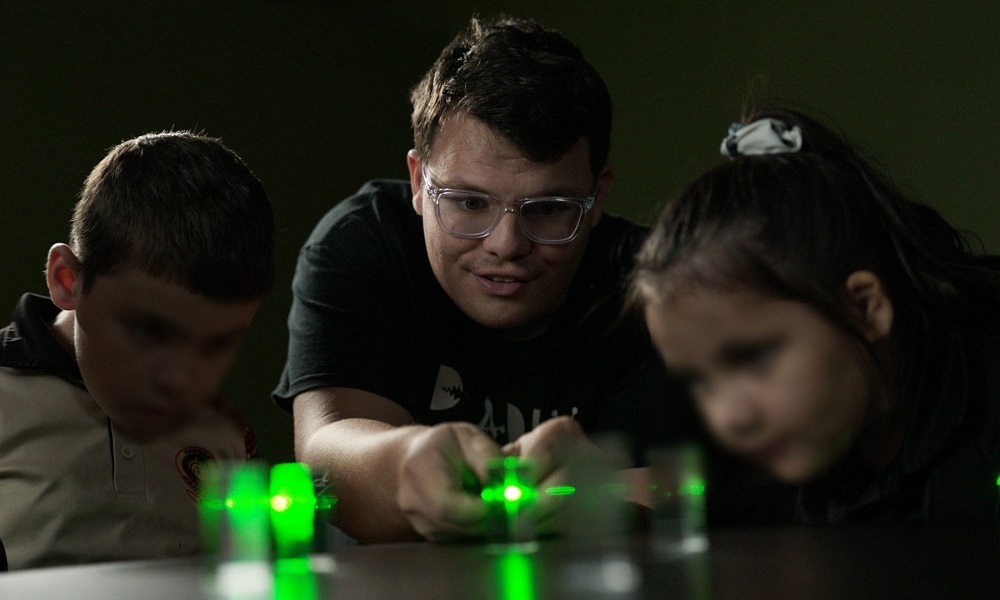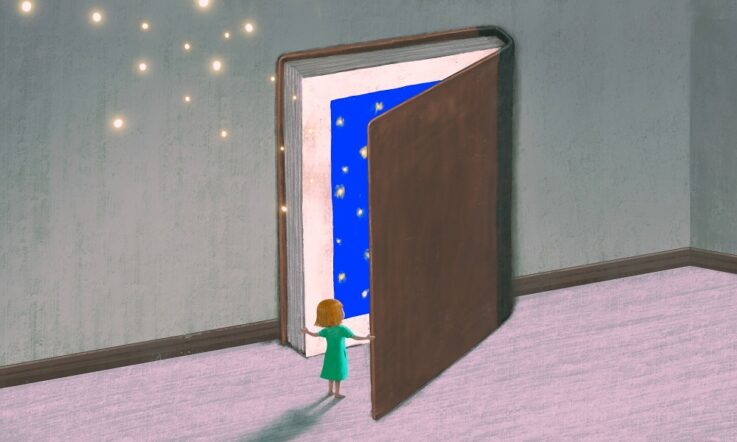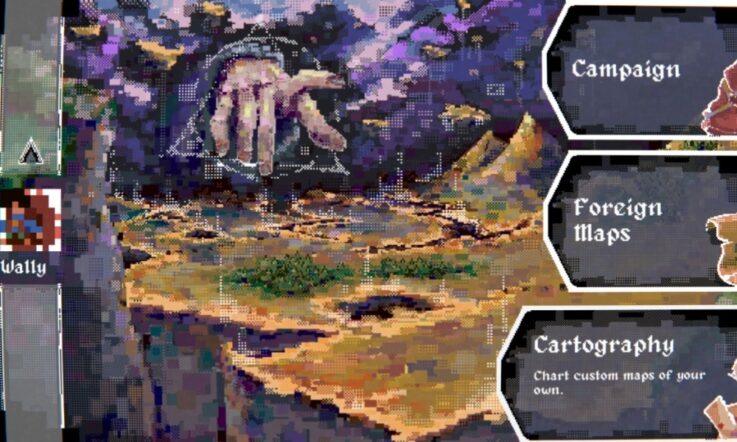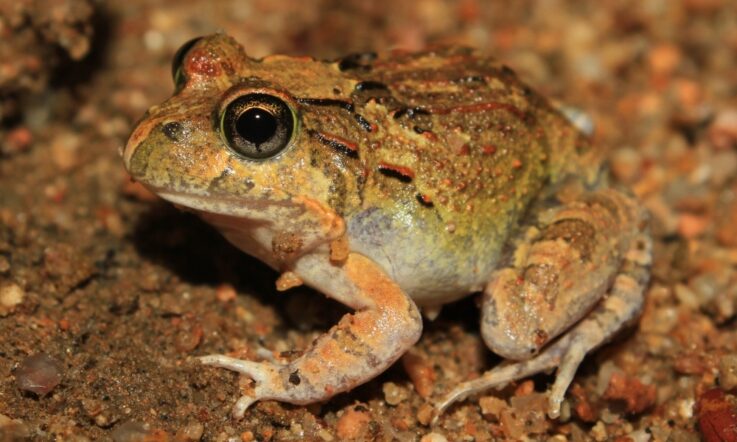This podcast from Teacher is supported by the Megamix Social schools program at Arts Centre Melbourne. Search Megamix Social to access free performing arts experiences for your students.
Thanks for listening to this podcast special from Teacher magazine. I’m Zoe Kaskamanidis.
It’s clear that books and resources have a big impact on student learning, so when schools are under-resourced, it can create extra barriers for students to engage with important content and can make it harder for teachers to teach. This problem is magnified even more when we’re talking about remote schools with limited access to resources, especially resources that connect schools with the important work and knowledge of First Scientists in Australia.
I’m joined in this episode by Corey Tutt OAM, founder and CEO of Deadly Science – an organisation that provides science resources to remote schools in Australia, to inspire and celebrate the next generation of Indigenous people in STEM.
Zoe Kaskamanidis: Corey, thank you for joining Teacher magazine. To start us off, can you tell us a bit about yourself, your own school experience, and how Deadly Science started?
Corey Tutt: Yeah yaama everyone! My name’s Corey Tutt. I’m a proud Kamilaroi man, and you know, very interesting that my career in science started off as a child, picking up lizards and snakes and we always know that kid that always picked up reptiles. And I pretty much never grew out of it. I dreamt of being Harry Butler or Harold Cogger or even Rod Bull. These were herpetologists that I grew up idolising.
But for me, being a young Aboriginal man from Nowra as well, working in science wasn’t really something that I was encouraged to do. The only real praise I got at school was when I was scoring tries on the footy field or – you know, those are the kinds of things that we encourage Aboriginal and Torres Strait Islander students to be.
And for me, I was always really interested in reptiles and history and animals and things like that. So when time came and I was about to leave school, it was fairly difficult because I wasn’t the best kid because of my upbringing. I had a lot of trauma in my life, and I desperately wanted to be that wildlife documenter.
So I had three options, which was zookeeper, wildlife documenter – and my cousins always used to laugh and say, ‘you’re David Attenborough’ – but for me, the third one was ABC sports commentator because I knew I could talk and I knew I liked footy, and that could sponsor the other two.
And I was told by my careers advisor that I better stick to a trade because kids like me end up probably dead or in jail. And they were some harsh words at the time, but I took them literally. And I left home at 16, saved up some money and I went over to Boyup Brook in Western Australia and started working in a wildlife sanctuary there.
And after a few months I’d come back to start studying zookeeping and animal studies, and going for my animal courses, and I worked at – which is now known as Shoalhaven Zoo, but it was called Nowra Wildlife Park back then. And I had to prove myself there and eventually I got that first zookeeper uniform; I got that first pay check as a zookeeper and it was my proudest moment.
And this is a trigger warning as well, but you know, when you’re working for very, very little pay and also travelling a considerable distance for work, you really have to love the job and I certainly did love the job, but then my best mate passed away which was not great. And just like most young people, we have ebbs and flows, and sometimes we can be driving along and we hit a pothole, and that was probably me.
And it accumulated me probably resigning from the Zoo. And I saw an ad in the paper for an alpaca handler and I figured, you know what? I’m already feeding a four-metre crocodile and picking up snakes, I’m sure I can handle an alpaca.
First alpaca I ever shore after being shown how to put them down, it head butted me in the face and broke my cheekbone. And it was masculinely named Pikachu as well, which was… again, I wish it was named like Thor or like, you know, Hercules or something like that, but no it was named Pikachu. The granddaughter of the farmers that bred it named it that.
So, you know, the moment I realised I was a resilient person was when I kept shearing and I kept going and I did it for a few years, and then I kind of got sick of it because all my mates were getting girlfriends and things and I actually wanted a normal job – a nine-to-five job. So I started working at the RSPCA and then I learnt how to do Delta training (which is like the dog training) and I learnt how to do rehabilitation.
It was a hard job, because you had to see the very best and the worst of humanity in the same day. And it was very, very tough. And then I moved on to the Animal Welfare League in Ingleside and I worked there, and I was the only male in the shelter for a long time, so it meant any dig scary dogs were sent my way.
And that’s where I met my partner and I decided then I wanted more for myself. And I was probably – you know, I was very, very smart and I probably didn’t realise I was smart until that moment.
And I started working at Garvan Institute, and I learnt how to be an animal technician, I did my courses down there, I learnt genetics, I learnt medical research, I learnt how to read a paper, I learnt how to breed mice for medical research which is pretty complicated as well. I learnt all about mortality rates and how a certain pheromone or a bit of cologne or aftershave can affect the mice and how they breed and things like that. And then I moved on to the University of Sydney where I worked as an animal tech from 2015 all the way on to 2019.
From there I started Deadly Science and I started working with kids in Waterloo and Redfern and discussing all things science. Because in my career in the animal industry and my long career, I’d met very few Aboriginal people. Actually, it was quite sad. And I was always quite sad about that. Because not many people had big brown eyes or a big black nose like me and not many people looked like me or experienced the things that I experienced so I felt really isolated in those industries.
And I always thought, ‘I wonder how many other kids are like me who have potential, but they just don’t have the right upbringing or the right opportunities.’
So for me, I really was at a stage where I needed to start giving back, and I needed to feel… Like for me to find my purpose, I needed to reach out and talk to other people. And it was really great. I started working with these kids and started talking about all things science.
And then we found out they just had no resources. Like, kids at a young age just didn’t have books and things like that. And I just decided to do something about it. It was nothing complicated about it. I didn’t feel right, you know, remote schools not having any books or resources.
And I started Googling remote schools, and yarning with them, and found they were just really under-resourced. And that was terrible. So I started sending resources out to remote communities, I started working two jobs.
And then I started a GoFundMe as well, and the GoFundMe ended up raising something like $250,000 over its lifetime. And then it turned into a charity. And then June last year I decided I would employ myself with Deadly Science and it kind of grew from there.
And now we send thousands of resources, we engage kids online and in person. But it really was just born out of, you know, I see that its wrong that kids don’t get the opportunity and I wanted to find a solution for it and that’s all it really is.
ZK: We’ll hear more from Corey after this quick message from our sponsor.
You’re listening to a podcast from Teacher magazine, supported by Megamix Social at Arts Centre Melbourne. Megamix Social is a free program of performing arts experiences for schools. Primary and secondary students can attend live music, theatre, circus, tours and workshops. Our program has been designed to ignite excitement, build friendships and re-engage students after remote learning. Visit artscentremelbourne.com.au/megamixsocial.
ZK: You spoke a lot about how remote schools are under-resourced. So when you’ve spoken to educators in these schools, what was it they struggle with in terms of getting access to Indigenous resources in their classrooms? How did you first notice this gap in resources?
CT: If you had of asked me this when I was in high school I would’ve had a completely different answer for you, but the thing for me is that teachers often are overworked. They’re often underappreciated. When the school day ends, the teacher’s day doesn’t necessarily end, because there’s a lot of prep that goes into teaching kids.
There’s a lot of things that we probably don’t see as students when we’re young. You know, for me the gap in resources actually effects not just students, it effects teachers. Teachers are often using their own money and resources to purchase things for their students.
And for me, the gap in Indigenous knowledges, it comes from colonisation, and colonisation alone. The fact that we’ve deleted histories and we’ve deleted knowledges means that non-Indigenous people don’t understand Indigenous perspectives. And how can we possibly expect non-Indigenous teachers to teach Indigenous perspectives in the curriculum when they haven’t had the opportunity to learn it.
ZK: Yeah, and we know that Aboriginal and Torres Strait Islander people have been practising science longer than any other culture, but still make up a very small proportion of scientists in Australia. Why is it important that students in remote communities have better access to STEM resources early in life? Especially resources that connect students with the knowledge of First Scientists in Australia?
CT: Really important because STEM is just as important as literacy, especially at that developmental age. Just having the access to Lego and learning how to build things, it encourages our kids’ mathematics, it encourages our kids to be able to create. It encourages kids to think outside the block– the box (the ‘block’ – Lego pun). But for me, the thing that it does is that it encourages kids to play with each other and share ideas. So it’s good for building relationships.
And often when we think of scientists, we think of lab coats, we think of Albert Einstein, we think of Thomas Edison, but that’s not necessarily what a scientist looks like.
And science and STEM really brings young people together. You know, just looking at some of the photos we got today, and when I look at the young kids playing with Lego that Deadly Science sent them, they’re all showing each other in the photos what they built. And it’s that light bulb moment – that that’s the thing that brings us together.
So I think science is a– you know, we always say sport brings people together, but I actually think STEM brings people together as well. And it’s really important that these resources are sent to schools because it’s, you know, whether you can speak English or read or write very well, it honestly does not matter. It doesn’t matter who they are, they just need that opportunity. And that’s the most important thing.
ZK: And I have to say a big congratulations on your Eureka Prize win last year. Since Deadly Science started, you’ve shipped over 16 000 books and 500 telescopes, and other STEM resources out to over 100 remote schools in Australia, which is just fantastic. Can you tell me a bit more about the impact this has had for students in these schools and remote communities?
CT: We’ve been sending resources at an alarming rate these last couple of months because we’ve just been trying to get as many resources out as possible. It’s been a hectic sort of time.
So we work with over 100 remote community schools now, and it’s been really important. So we’re doing some really great stuff in that area. And when you work with over 100 schools, you have so many interesting conversations that you have to have, and it’s very, very hard.
It’s opened the door for a lot of kids. You know, there’s been a couple of kids that, you know, they may have had behavioural issues related to trauma and things like that. And for example, there’s been one school that we had, and one of the principals said to us that there’s a little boy in that school that really struggled in getting to class, but the Deadly Science books that we donated have provided that kid with an opportunity to actually go to school and sit in the classroom and still learn.
So the resources itself, the mentoring, has actually been able to get the kids back in the classroom which is really important.
ZK: And speaking of mentoring, can you tell us a bit about how mentorship in STEM can work within remote communities and how this impacts student learning?
CT: You can’t be what you can’t see. And allowing kids to connect with scientists and STEM professionals opens up the opportunity for young people to see themselves in careers. You know, just like Harry Butler was for me, or Paul Sinclair, or anyone that has worked in the space that’s Indigenous, or non-Indigenous, that inspires the next generation. There’s a lot of people that can inspire these kids.
So giving these kids access to those people. Because you never know. I always think when I sign a book for a kid, or I connect with a young student in a remote community… I always remember the time that I got my football signed by like an NRL player, right? And I know it’s different, but if I can be that moment for someone else, and some other young person, then I’m tickled pink. I think that’s great.
So, every time we can provide that moment – that life-changing moment – we have the opportunity to do that every day and we’re very, very lucky to have that.
ZK: And how can schools start to do things differently to better learn about, celebrate and inspire Indigenous people in STEM?
CT: Engage your First Nations communities. Engage your Elders, engage your AO's, empower your kids, don’t put too much pressure on your kids to do acknowledgement of Country’s and things like that. Listen to them, listen to their perspectives. There’s plenty of great literature out there, so you can actually buy a lot of books that have a lot of Aboriginal science and Indigenous perspectives in there.
So, I think there’s many ways you can get involved. I think just having an open mind, and sometimes the greatest victories in life are not done by our arms or legs or our mouth, it’s done by our ears. So just deep listening, and practicing deep listening really helps.
ZK: Yeah they’re really great points. And to finish off, if schools want to find out more, how can they connect with you?
CT: They can jump on deadlyscience.org.au and they can send us a message via the website, and we’ll get in contact with them.
ZK: Fantastic, well it’s been great speaking with you Corey, thanks so much for joining us!
CT: Yeah it’s been awesome. Stay safe, stay deadly and thank you for your time.
That’s all for today’s episode, thanks for listening. If you haven’t already, be sure to subscribe to our podcast channel on Spotify, Apple podcasts, SoundCloud, or wherever you get your podcasts from, so you can keep up to date with our latest episodes. If you want to keep listening now, you can access the 200+ episodes already in our archive. And, while you’re there, we’d love it if you could rate and review us.
You’ve been listening to a podcast from Teacher, supported by the Megamix Social schools program at Arts Centre Melbourne. Search Megamix Social to access free performing arts experiences for your students.
Corey Tutt says: ‘You can’t be what you can’t see. And allowing kids to connect with scientists and STEM professionals opens up the opportunity for young people to see themselves in careers.’
As a teacher, think about the professionals you have invited into your classroom so far this year. Have these professionals reflected the diversity of students in your classroom?
To get in touch with Deadly Science, contact admin@deadlyscience.org.au or to go to the website to find out more about donations.



